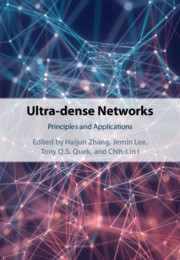Book contents
- Frontmatter
- Contents
- List of Contributors
- Part I Overview
- Part II Physical Layer Design
- 3 NOMA-Based Ultra-dense Networks
- 4 Physical Layer Security in Ultra-dense Networks
- 5 Millimeter-Wave Multiantenna Ultra-dense Networks
- 6 Interference Management in Ultra-dense Networks
- 7 3D-Based Base Station Deployment in Ultra-dense Networks
- 8 Power Control in Full-duplex Ultra-dense Heterogeneous Networks
- Part III Resource Allocation and Network Management
- Part IV Field Trials and Tests
- Index
4 - Physical Layer Security in Ultra-dense Networks
from Part II - Physical Layer Design
Published online by Cambridge University Press: 12 October 2020
- Frontmatter
- Contents
- List of Contributors
- Part I Overview
- Part II Physical Layer Design
- 3 NOMA-Based Ultra-dense Networks
- 4 Physical Layer Security in Ultra-dense Networks
- 5 Millimeter-Wave Multiantenna Ultra-dense Networks
- 6 Interference Management in Ultra-dense Networks
- 7 3D-Based Base Station Deployment in Ultra-dense Networks
- 8 Power Control in Full-duplex Ultra-dense Heterogeneous Networks
- Part III Resource Allocation and Network Management
- Part IV Field Trials and Tests
- Index
Summary
This chapter studies the potential of physical layer security in future ultra-dense networks. The unique features of ultra-dense networks are summarized, which can be exploited to enhance the secure transmission at the physical layer. We illustrate that physical layer security can be implemented in many use cases such as vehicle-to-everything, edge computing and caching services, to safeguard the confidential messages. The opportunities and challenges in these research areas are presented.
- Type
- Chapter
- Information
- Ultra-dense NetworksPrinciples and Applications, pp. 51 - 63Publisher: Cambridge University PressPrint publication year: 2020

